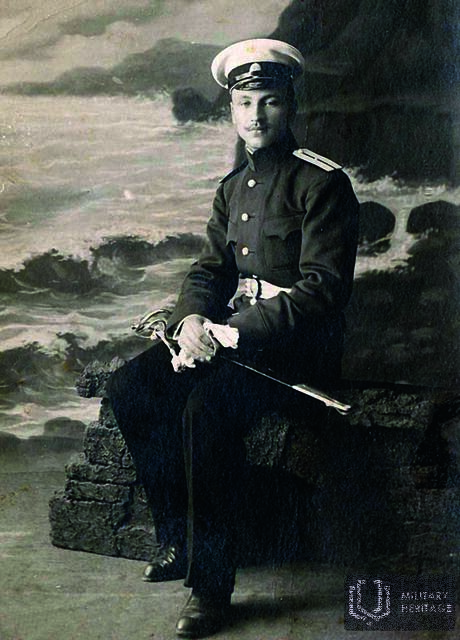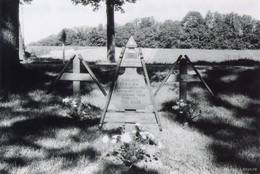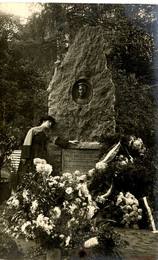Vilis Gelbė (taip pat Gelbė, 1890-1919), laivyno leitenantas
I WW1, I Nepriklausomybės karai
Vilis Gelbė gimė 1890 m. lapkričio 8 d. Zemytėje. Jis baigė vietinę mokyklą, Talsų miesto mokyklą, vėliau Engurės ir Pēterpilio jūrų mokyklas. Jis gavo tolimojo nuotolio vairininko diplomą, o 1918 m. liepos mėn. baigęs Oranienbaumo jūrų mokyklą – ir kapitono diplomą. Pirmojo pasaulinio karo metu jis buvo laivų „Kotka“ ir „Arguņ“ vadas, dalyvavo operacijose prieš vokiečius.
1918 m. pabaigoje jis atvyko į Latviją ir įstojo į Latvijos ginkluotąsias pajėgas. 1919 m. pradžioje Vilis Gelbė veikė nuo bolševikų išlaisvintoje Šiaurės Latvijoje, kur turėjo eiti Valmieros apygardos komendanto pareigas. Jis buvo vienas iš tų, kurie praktiškai dirbo kurdami Šiaurės Latvijos brigadą, kuri, pagal susitarimą su Estija, buvo suformuota vadovaujant Estijos kariuomenei. 1919 m. gegužės pabaigoje Vilis Gelbė buvo komanduotas į Limbažius, kuriuos jau buvo be kovos okupavę Estijos kareiviai, nes komunistai pabėgo į Valmierą. Jis buvo pirmasis Limbažių ir apylinkių karo komendantas. Iš Limbažių gyventojų, įskaitant vyresniųjų klasių moksleivius, pradėtas formuoti pirmųjų karinių dalinių formavimas. Vadui Viliui Gelbei teko veikti Limbažiuose ir apylinkėse labai sunkiu metu, kai buvo ruošiamasi karui su vokiečių Geležine divizija ir Landesveru didžiulėje Vidžemės teritorijoje, žinomame kaip Cėsių mūšis. Darbą dažnai apsunkindavo kasdieniai konfliktai tarp vietos gyventojų ir Estijos kareivių.
Cėsių mūšio metu Vilis Gelbė ir jo komendanto vyrai dalyvavo mūšiuose su vokiečių Geležinės divizijos kariais. 1919 m. birželio 19 d. netoli Vidrižų dvaro Gelbė ir jo vadovybė išskubėjo pulti vokiečių skaičiumi persmelktų karių, savo drąsa padrąsino karius kovoti, taip užtikrindami mūsų pajėgų dešinįjį sparną. Šio mūšio metu jis žuvo didvyrio mirtimi ir 1921 m. po mirties buvo apdovanotas Lačplėšio karo ordinu, III laipsniu. Vilis Gelbė palaidotas Limbažių kapinėse.
Vilio Gelbės antkapinis paminklas buvo atidengtas 1922 m. rugsėjo 10 d. tuometinio Latvijos prezidento Jānio Čakstės. Paskutinio Vilio Gelbės mūšio vietoje Vidrižų dvaro parke taip pat buvo pastatytas atminimo ženklas.
Daugiau informacijos šaltinių
Jānis Ulmis „Už mylimą tėvynę...: Lāčplės karo ordino kavalierius, karinio jūrų laivyno leitenantas Vilis Gelbė apie Šiaurės Latvijos ginkluotųjų pajėgų formavimą ir Latvijos išsivadavimo karo Cėsių mūšius“. Limbaži: Limbažių muziejus, 2018 m.
Jānis Ulmis. Lačplėsio karo ordino kavalierius, jūrų leitenantas Vilis Gelbė, dalyvavęs Šiaurės Latvijos ginkluotųjų pajėgų formavime ir Cėsių mūšiuose Latvijos išsivadavimo kare. (Knygos ištraukos): https://limbazi.lv/novads/vesture/cesu-kaujas/6841-lacplesa-kara-ordena-kavaliera-juras-virsleitnantavila-gelbes-loma-ziemellatvijas-brunoto-speku-izveide-un-latvijas-atbrivosanas-kara-cesu-kaujas-landesvera-kara
Lāčplėsio karo ordino kavalieriaus Vilio Gelbės biografija: http://lkok.com/detail1.asp?ID=533
Susijusios vietos
Paminklas Vidrižuose, toje vietoje, kur žuvo LKOK Vilis Gelbe ir du jo komandos kariai.
Vidrižuose, ties posūkiu į Lėdurgą, Nepriklausomybės kovų metu, 1919 m. birželio 19 d., mūšyje žuvo jūrų leitenantas Vilis Gelbė ir du kareiviai.
Vilis Gelbė palaidotas Limbažų kapinėse. Už didvyrišką poelgį prie Vidrižių dvaro Vilis Gelbė buvo apdovanotas Lāčplėsio karo III laipsnio ordinu (Nr. 895).
Šiuo metu mūšio vietoje galima pamatyti tris Pemino kryžius, įrengtus 1989 m.
1934 m. birželio 22 d. prie dvaro parke augančio klevo buvo atidengta bronzinė atminimo lenta, sukurta menininko Stefano Berco vardu. Jau komunistinės okupacijos pradžioje, 1940 m. rudenį, atminimo lenta dingo. Klevas, prie kurio ji buvo prikalta, taip pat žuvo. Prasidėjus Atbudimui, 1989 m. birželio 19 d., minint Gelbės ir dviejų jo komandos karių – kapralo Krustinio ir eilinio Krūzės – žūties 70-ąsias metines, kryžkelėje, kur kadaise stovėjo atminimo lenta, Aplinkos apsaugos klubo ir Latvijos liaudies fronto Limbažių rajono skyrių iniciatyva buvo pastatyti trys mediniai kryžiai, pagaminti Janio Eglītio liaudišku stiliumi. Limbažių rajono vykdomojo komiteto sprendimu 1991 m. balandžio mėn. ši atminimo vieta buvo įtraukta į vietinės reikšmės istorinių paminklų sąrašą.
Paminklas karinio jūrų laivyno leitenantui L.k.o.k. Vilis Gelbes (1890-1919)
Įsikūręs Limbaži Jūros gatvės kapinėse, Jūros g. 56, Limbaži
Eksponuojamas paminklas, kurį 1922 m. rugsėjo 10 d. atidengė tuometinis Latvijos prezidentas Janis Čakste, su poeto Vilio Plūdonio dedikacija Viliui Gelbui:
„Mano žmonės, kurie eina pro mane, dega meile savo tėvynei,
"Dėl savo mylimos tėvynės pažadu savo gyvybę."
Vilis Gelbė (1890–1919) gimė Kurše, Zemytės valsčiuje, tačiau buvo glaudžiai susijęs ir su Limbažių puse, nes prasidėjus Latvijos nepriklausomybės karui, iš Sankt Peterburgo grįžo į Latviją ir įstojo į Šiaurės Latvijos brigadą.
1919 m. gegužę V. Gelbis vadovavo Limbažiuose, tapo srities karo komendantu ir sugebėjo įkvėpti vietos vyrus ir net labai jaunus berniukus stoti į kariuomenę.
Tuo metu V. Gelbės veikla Limbažiuose ir apylinkėse buvo labai reikšminga; jo pareigos apėmė ne tik tvarkos palaikymą mieste ir apylinkėse, bet ir mobilizaciją, kareivių ir arklių aprūpinimą maistu bei daugelio kitų klausimų, kurie negalėjo būti įtraukti į įsakymus ir instrukcijas, sprendimą. Jo organizuota komendanto komanda veikė kaip koordinuotas mechanizmas, suteikiantis Šiaurės Latvijos brigadai kuo efektyvesnę pagalbą. Komendanto komanda ypatingais atvejais eidavo į pagalbą reguliariajai armijai, o naujiesiems kariams rodydavo pavyzdį. V. Gelbė buvo pirmasis Latvijos armijos karininkas, pasiūlęs savo pavaldinius apdovanoti III laipsnio Imantos ordinu. Ordino tuo metu dar nebuvo. Imantos vardas viešumoje pasirodė tik 1920 m. kovo 20 d., kai saugumo ministrui Kārliui Ulmaniui buvo pateiktas siūlymas dėl karinio ordino įsteigimo. Tačiau ordinui buvo pasirinktas Lāčplēsio vardas.
Cėsių mūšio metu Vilis Gelbė žuvo 1919 m. birželio 19 d. žvalgybos misijos metu. Vėliau Gelbė buvo apdovanotas Lačplėšio karo ordinu, tačiau istorikai mano, kad jo indėlis nebuvo tinkamai įvertintas. Taip yra daugiausia dėl Gelbės narystės Šiaurės Latvijos brigadoje.
Vadinamoji Pietų Latvijos brigada, kuriai iš pradžių vadovavo Oskaras Kaplakas, o vėliau – Janis Baložas, varžėsi su Šiaurės Latvijos brigada, kuriai vadovavo Jorgis Zemitānsas.
Paminklas žuvusiems Latvijos išsivadavimo karo kariams atminti
Paminklas yra šalia Limbažių Šv. Jono liuteronų bažnyčios, Lībiešu g. 2. Čia pastatytas memorialas žuvusiems Limbažių ir apylinkių kariams bei generolui leitenantui Viliui Gelbei (1890–1919), žuvusiam 1919 m. birželio 19 d. Vidrižuose mūšyje su vokiečiais.
Generolo leitenanto Vilio Gelbės paminklą galima pamatyti Limbažių kapinėse, Jūras gatvėje.
Susijusi istorija
Apie nacionalinį patriotą pirmąjį leitenantą Vilį Gelbį
Pulkininko leitenanto Vilio Gelbės (1890–1919) likimas atspindi sunkią situaciją kuriant mūsų valstybę ir kariuomenę, taip pat šių įvykių vertinimą.
1918 m. lapkričio 18 d. paskelbus Latvijos valstybę, prasidėjo Latvijos nepriklausomybės karas ir ginkluotųjų pajėgų kūrimo darbai. Pirmosiose Latvijos savanorių kareivių gretose buvo Kurše gimęs jūrų leitenantas Vilis Gelbė.
Cėsių mūšio pradžia, eiga ir pabaiga
Pergalė Cėsių mūšyje turėjo tapti lūžio tašku Latvijos ir Estijos kovoje už savo šalies nepriklausomybę. Ši pergalė sustabdė Andrijevo Niedros vyriausybės ir vokiečių generolo Rüdigerio fon der Golco planus užkariauti Pabaltijį. Vietoj to, Liepojoje savo veiklą atnaujino Karlio Ulmanio vadovaujama Laikinoji Latvijos vyriausybė.









![Limbažiai. Prezidentas J. Čakste atidengia paminklą Limbažiuose žuvusiems Pirmajame pasauliniame kare. Latvijos Laisvės Kovos Paminklo atidengimas [1923]. Šaltinis: Latvijos nacionalinės bibliotekos skaitmeninė kolekcija „Dingusi Latvija“.](/g/Poi/00403/44213.png?size=260)